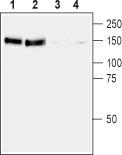RET Rabbit Polyclonal Antibody
Frequently bought together (2)
Transient overexpression lysate of ret proto-oncogene (RET), transcript variant 2
USD 665.00
beta Actin Mouse Monoclonal Antibody, Clone OTI1, Loading Control
USD 200.00
Other products for "RET"
Specifications
| Product Data | |
| Applications | FC, IF, IHC, WB |
| Recommended Dilution | WB: 1:200-1:2000; IHC: 1:100-1:3,000; FC: 1:50-1:600 |
| Reactivities | Human, Mouse, Rat |
| Host | Rabbit |
| Clonality | Polyclonal |
| Immunogen | Peptide CEWRQGDGKGITR, corresponding to amino acid residues 541-553 of human Ret. Extracellular, N-terminus. |
| Formulation | Lyophilized. Concentration before lyophilization ~0.8mg/ml (lot dependent, please refer to CoA along with shipment for actual concentration). Buffer before lyophilization: phosphate buffered saline (PBS), pH 7.4, 1% BSA, 0.05% NaN3. |
| Reconstitution Method | Add 50 ul double distilled water (DDW) to the lyophilized powder. |
| Purification | Affinity purified on immobilized antigen. |
| Conjugation | Unconjugated |
| Storage | Store at -20°C as received. |
| Stability | Stable for 12 months from date of receipt. |
| Gene Name | ret proto-oncogene |
| Database Link | |
| Background | The RET proto-oncogene on human chromosome 10q11.2, encodes a receptor tyrosine kinase (RTK) activated by members of the glial cell line-derived neurotrophic factor (GDNF) ligand family (GDNF, neurturin, artemin, and persephin) in conjunction with a ligand-specific coreceptor (GFRa1-4). RET belongs to the cadherin superfamily, and it has been suggested that the ret gene is the result of a recombination between a gene encoding a tyrosine kinase receptor and a gene encoding an ancestral cadherin at an early stage of evolution. The extracellular domain of RET comprises, as observed for other tyrosine kinase receptors, a cysteine-rich domain, but also four cadherin-like domains. RET signaling is crucial for the development of the enteric nervous system. RET also regulates the development of sympathetic, parasympathetic, motor, and sensory neurons, and is necessary for the postnatal maintenance of dopaminergic neurons. Outside the nervous system, RET is crucial for development of the kidney and plays a key role in spermatogenesis. RET has attracted considerable clinical interest because of the range of mutations found in diverse conditions that include Hirschsprung disease and a variety of cancers involving the thyroid gland. RET-related cancers with thyroid involvement include sporadic and familial medullary thyroid carcinoma (MTC), multiple endocrine neoplasia 2 (MEN2) syndromes MEN2A and MEN2B, and papillary thyroid carcinoma (PTC). |
| Synonyms | CDHF12; CDHR16; HSCR1; MEN2A; MEN2B; MTC1; PTC; RET-ELE1; RET51 |
| Note | This antibody was tested in live cell imaging. Please see IF/ICC data for detail. |
| Reference Data | |
| Protein Families | Druggable Genome, Protein Kinase, Transmembrane |
| Protein Pathways | Endocytosis, Pathways in cancer, Thyroid cancer |
Documents
| Product Manuals |
| FAQs |
| SDS |
{0} Product Review(s)
0 Product Review(s)
Submit review
Be the first one to submit a review
Product Citations
*Delivery time may vary from web posted schedule. Occasional delays may occur due to unforeseen
complexities in the preparation of your product. International customers may expect an additional 1-2 weeks
in shipping.






























































































































































































































































 Germany
Germany
 Japan
Japan
 United Kingdom
United Kingdom
 China
China






